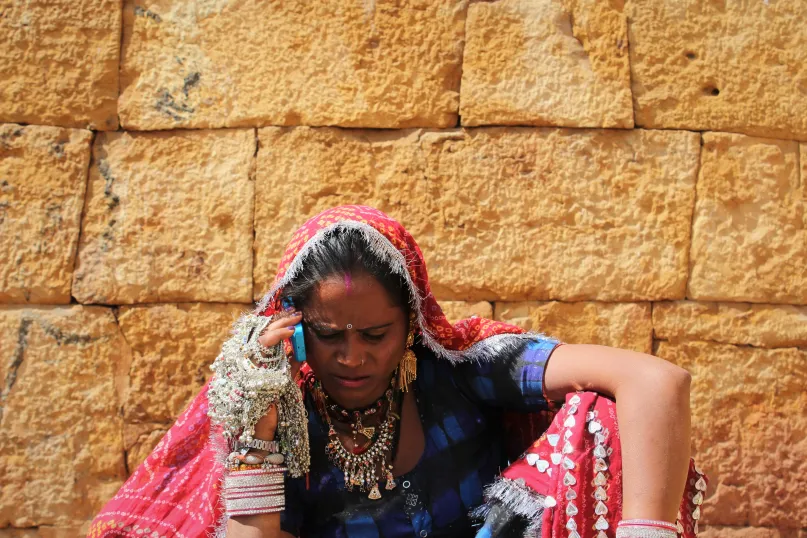Grappling With India’s National Biometric-Based Payments System

India’s Aadhaar Enabled Payment System (AePS) is the world’s first national biometric-based payments system. In the two years since its launch, AePS has revealed both benefits and challenges as it seeks to expand financial inclusion. Grameen Foundation India has experienced these directly as we work to scale digital financial services and financial education.
How does AePS work?
AePS was designed to allow individuals to conduct financial transactions across any participating bank, using just three inputs:
- A number identifying the bank;
- The customer’s own national identification number, assigned using biometric data such as finger prints for identification; and
- The customer’s fingerprint, which provides user authentication at the time of transaction.
Transactions can take place at a bank registered with the system, or at a Point of Sales (PoS) machine set up through bank “business correspondents” such as microfinance institutions (MFIs). This brings access, convenience and cost savings to rural customers who live far from a bank branch.
Grameen Foundation India’s experience with AePS
In a project funded by Citi Foundation, we incorporated AePS to help expand financial inclusion for poor and low-income women in the state of Uttar Pradesh. With our partners Sonata Finance, a leading Indian MFI, and Oxigen, a leading payment solution provider, the project reached out to women through 150 Sonata branches, where trained staff could assist clients in using the digitally-based PoS machines.
From March 2017 to November 2017, clients made more than 32,000 transactions worth USD 110,448 (INR 74 million) at Sonata branches. They made payments on individual or group loans from Sonata, deposits, and withdrawals. More than 58,600 women clients were trained on the AePS platform, and 15,760 made transactions.
An impact study of the project carved out some of the key advantages and challenges faced with AePS platform.
Key advantages for women clients:
- High Trust – Most of the low-income women clients were illiterate; 76% of clients had completed no more than primary education. When visiting a bank on their own, these women were dependent on strangers for filling deposit or withdrawal forms. The AePS platform meant there were fewer forms to fill, and the women could be assisted by the trusted local branch staff. This became a big incentive for women to adopt digital financial services.
- Convenience and Interoperability – Clients appreciated being able to make multiple transactions for different accounts at different banks under a single roof, saving time and travel expenses. Previously, clients living at distant locations often travelled as a group to do their banking, for reasons of both safety and friendship.
- Ease of Transaction – Clients didn’t have to provide any document apart from their Aadhaar number. Previously, they needed bank passbooks and related documents, and just signing the documents could be intimidating.
- No Transaction Fees – Unlike mobile wallets, AePS does not charge any service fees to the client. Mobile wallet fees could be as high as 1.5% to 2% of the transaction amount.
Key challenges for clients:
- High Transaction Failure Rate – About 56% of the total transactions conducted during the project period failed, compared to a 60% failure rate for AePS nationally. This is astronomical by any standards. About 20% of the failed transactions were due to user issues, including incorrect Aadhaar numbers and insufficient bank balance. About 45% were due to technical glitches, including poor internet connectivity.
- Biometric mismatch - About 35% of the failed transactions were due to biometric mismatch. Most women clients were engaged in jobs requiring rigorous manual labor, which resulted in eroded fingerprints that led to failed fingerprint recognition. This results in the exclusion of a large section of society, which is unable to reap the immense benefits of this platform.
- Failed transaction causing balance deductions - In many cases, transactions failed to complete, but payment amounts were still deducted from clients’ accounts. Furthermore, it took roughly a month for the amount to be reposted. This is a major barrier, especially for low-income households whose small accounts had little margin for error.
Clearly, although benefits to the system were strong, operational challenges present severe limitations to the AePS system. Due to the regular failure of transactions, many clients expressed feeling discouraged from using the platform.
For AePS to deliver fully on its promise of expanding financial inclusion in India, these experiences point to the need for several crucial changes. AePS must reduce the number of failed transactions, and expedite the redress of failed transactions. To do so, three main issues must be addressed:
- Finding a practical alternative to fingerprint authentication;
- Continuing to strengthen the internet infrastructure in rural areas; and
- Complimentary efforts to strengthen the digital and financial literacy of low-income women such that they enter the banking environment confident and well-prepared.



Good to read insights from practical implementation at the ground. AEPS is best digital payment tools for rural population but there are challenges in implementation as mentioned in the article.
I am also foreseeing one more challenge. There is lot of buzz about Aadhaar recently, both positive and negative, because of ongoing legal case in Supreme Court. Due to this there could be some hesitation in people to share their Aadhaar number and fingerprints with AEPS service providers. Although, it might be more in urban areas.
The rural population get more benefit from this. And this is the big success.
Why the issue raised around authentication is a fair one, and it remains a significant challenge, I think this analysis may suffer from selection bias.
MicroSave recent conducted a study on fertiliser subsidy distribution and looked at this issue.
Attempt Total farmers authenticating Success Failure %age successful
Ist 4407 2732 1675 62%
2nd 1675 1190 485 71%
3rd 485 353 132 73%
More 132 132 0 100%
All 4407 farmers were able to authenticate successfully in three or more attempts but still authentication success rate would be 66% considering each attempt as unique.
Leave a comment